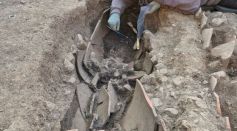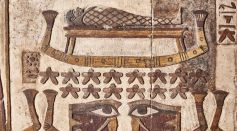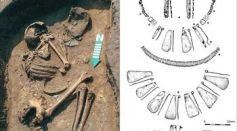Tags: Archaeology

French Archaeologists Discover Ancient Corsican Skeletal Remains Contained in Jars
Meet the Monkeydactyl: Oldest Flying Reptile With Opposed Thumbs

Extinct Tree-Climbing Kangaroo Species in Australia Discovered to be Relatives of Wallabies

2,500-Year-Old Mural is the Earliest Record of Salt as a Commodity Among Mayans
Remains in Ancient Massacre Site Examined, Genetic Analysis Reveals Large Scale Indiscriminate Killing
Rare Find: 70 Million Years Old Bird-Like Dinosaur Preserved in Nest of Fossilized Eggs Discovered

Ornate Roman Chariot Near Pompeii Found: Ancient Equivalent of Lamborghini Still "Almost Intact"

New Study Reveals Social Inequality Recorded in Medieval Cambridge
Early Money: Archaeological Discovery Shows Ancient European "Standardized Bronze Objects"
Calling Card for the Future: Plastic Waste Found at Iron Age Site
Russian Archaeologists Create a 3D Model for a Section of the Tepsei Site

Archaeology Dig Reveals 2,000 Year Old “Fast-Food” in Pompeii

German-Egyptian Research Team Restore Ancient Temple's Original Carvings and Paintings
Duckbill Dinosaur Discovery Offers Insights on How Dinosaurs Crossed The Ocean
Cutting Edge Tech Reveals Bronze Age Migration Routes of Livestock Herders
From the City of the Dead: 59 Coffins Found in Saqqara, South of Cairo
Researchers Date the Historic Ilopango Eruption That Destroyed Part of the Maya Civilization
Microbial Biomarkers Raise Possibilities of Ancient Humans Cooking in Hot Springs

Ancient Viking Helmet is Dated Back to the 10th Century

6,600-Year-Old Grave Sites Revealed Social and Economic Inequality Happened Even in Prehistoric Times
Most Popular

Will Earth's Magnetic Poles Flip Next? Magnetic Pole Reversal Explained Through Cutting‑Edge Magnetosphere Science

How Lightning Science Reveals Why Charged Storms Are Rising with Global Warming Effects

Relativity Time Dilation Explained: The Physics of Time and Why It Moves Differently in Space

Earthquake Magnitude vs Intensity: Key Differences Explained for Accurate Measurement




